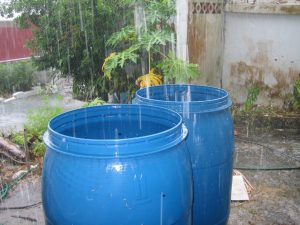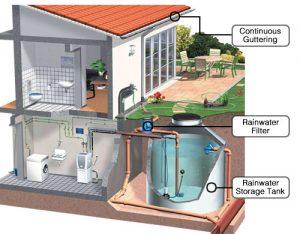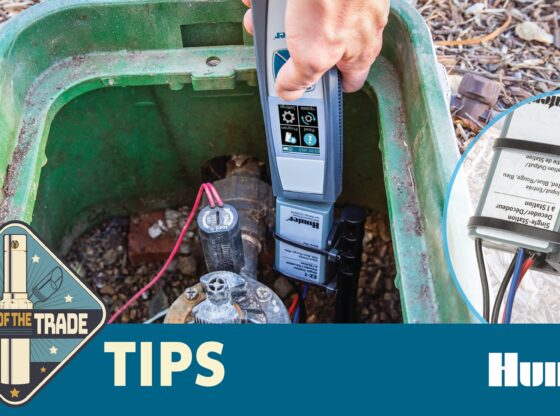Rain Water Harvesting is promoted for a few reasons. One of which is to collect and store rainfall to supply irrigation water. Nothing really new, humans have created storage for irrigation water ever since organized agriculture began.
Benefits of storing rain water in our modern age include;
- Reduced cost: If the owner purchases irrigation water, that cost can be greatly reduced (not eliminated) by using water collected on their property.
- Preservation of potable water: Utilizing treated potable water for landscape or agricultural irrigation really isn’t an efficient system. As more irrigation systems are removed from the potable water supply, this will reduce the burden for the water purveyor and free up more clean water for human needs.
- Storm Water Retention: If property owners are collecting, storing, and using rainwater on their properties, our over burdened sewage systems should see a decline in volume.
- Ownership: While water rights vary from state to state, generally water that falls on a person’s property belongs to them. Given their supply is large enough, they can irrigate all they want, even in times of drought.
 There are matters requiring thought and investment to collect, store, and use rainfall as a supply for irrigation. Some questions must be answered.
There are matters requiring thought and investment to collect, store, and use rainfall as a supply for irrigation. Some questions must be answered.
- How much rainfall can be collected?
- Will rain be available when supply replenishment is required?
- How much water can be stored?
- How much water is needed?
- When rain supply is insufficient, what supply will fulfill the irrigation requirement?
- What hardware will be necessary? (pumping, storage, control, treatment, and transport systems, etc)
Rain Water Availability
Rain water is commonly harvested from roofs, paved areas, or a watershed. To determine availability, the square footage of collection area is measured. Because of mechanical issues, not all water delivered by a rain event to the collection surfaces is collectible. General assumption is 50%. A simple calculation will then provide the estimated gallons per rain event that can be captured;
Gallons= 0.50 x Rain (inches) x Area (Ft2) x 0.623
Example: if historical average rainfall for the month of June is 2.5” and the collection surface is 1,300 Ft2, expected water collection will be 1,012 gallons.
Gallons= 0.50 x 2.5” x 1,300 Ft2 x 0.623 = 1,012.
A big question is how much rain can be expected and when will it happen. Areas with less volume of rainfall and/or little rain during the irrigation season may need exceptionally large storage capacity.
Matching the irrigation requirement to the rainfall volume, frequency and the storage capacity, will determine the supplemental water requirement. Typically, monthly historical rainfall data, the monthly irrigation requirement, and the size of the storage area, are used to calculate how much supplement water is needed and when.
Irrigation requirement
Irrigation requirement must be calculated by some means. It will vary greatly depending on climate, soil type, plant varieties, planted area, time of year, and production expectations. Any good irrigation person will know how to estimate monthly water volume requirements for a particular irrigation system.
Some general numbers may help.
- To apply 1” of water to an area equal to 1 acre, will require 27,154 gallons.
- A typical ornamental shrub will require 1-3 gallons per week during the mid summer.
- A planting of flowers or ground cover with near 100% canopy cover will need about 1 gallon per square foot per week.
Collection System
 Collection is normally an easy network to create. From roofs it means routing downspout water to the storage container. And, from paved areas it means collecting and or channeling water to the storage area. Lakes may be taking in run-off water from a watershed consisting of many acres.
Collection is normally an easy network to create. From roofs it means routing downspout water to the storage container. And, from paved areas it means collecting and or channeling water to the storage area. Lakes may be taking in run-off water from a watershed consisting of many acres.
The most difficult aspect may be pre-straining the collected water before it enters the storage medium. Screening removes the trash and debris moving along with the water. Maintaining water quality in the storage is much easier without debris!
Water Storage
Water can be stored a variety of ways. None are cheap and without issues.
Ponds and lakes are by far the most common storage facility for rain water collection. People have done so for eons. Lakes are relatively easy to construct if the land is available. They are also easy to scale to the water storage requirement and for large storage may be the only reasonable solution.
Lakes do require a suitable large flat surface area, which may not be present. Nor may a lake be approved by regulatory agencies. For many, a lake may not even be desired on the property. Work with knowledgeable engineers or excavation companies.
Tanks that are buried or on the surface require mechanics that vary somewhat but are similar. They also have an upper storage limit. Unless assembled on site, tank size is limited to what a truck can deliver.
There are many mechanical considerations when installing tanks. Some are not obvious but critical. Work with knowledgeable people. A botched installation is very costly to fix. Also learn about the safety, regulatory, and insurance requirements before investing.
Cisterns are similar to a buried tank, but utilizes constructed storage area like a basement or a rubber lined cavity supported by a matrix. They can be scaled to handle extremely large volumes of water. Almost as easy as a lake. Support matrix can be stout enough to support a paved area above the cistern such as a parking lot. Again, work with knowledgeable people!
Back-Up Water Supply
Supplemental water can be supplied by a purveyor, potable or non-potable. Or another on-site water source, such as a creek or well. Alternate supplies can be automated or managed manually.
Using measuring devices to determine when the supplemental supply is needed and automatically operating valves and pumps to refill the storage is desired by most users.
Water Quality
For irrigation purposes stored water quality is not a major concern. However, there are situations causing plant and soil health issues. Water should be tested for irrigation suitability. Most states have universities or private companies providing such tests.
Contaminants on a roof, parking lot, or watershed will enter the storage. Water stored over a long period of time will have growths of bacteria, insects, algae’s, and other life. Those issues must be foreseen before installation because costs often increase dramatically to retrofit later on.
Because irrigation will require large amounts of water, it usually means water is not stored for long. Tanks and cisterns will be emptied or turned before bacteria and such can become a problem.
However, a lake is never allowed to be completely drained. In fact, to maintain acceptable aesthetics and lake water health, irrigation use is limited to 1-3’ of depth. Lakes may need some treatment. Mechanical aeration is the suggested means because low oxygen levels are typically the issue. If oxygen levels are maintained, natural processes keep lake water very clean.
In conclusion, keep in mind all the details. Consider all the options for form of storage and the process that is needed. Contact a trained professional for advice and help.












My cousin has been thinking about how she can store more water, and be prepared for the warm months. She would really like to get some water tanks from a professional to be more effective. I liked what you said about how tanks that are buried have varying mechanics than those that are on the surface.
Thanks for pointing out that it’s important to work with knowledgeable people when installing a water tank to make sure that everything is done correctly and so you can learn more about it. My dad is thinking about getting an underground water tank for his property because he thinks that it would make his gardening and farming easier and that it would be good to have in case of an emergency. I think it would be smart for him to work with a professional when he gets it installed to make sure that it is going to work correctly and that he will know how to safely and efficiently use it.
I’m glad that you mentioned that water can be stored in tanks. I have been thinking about using this method but haven’t found a lot of information about it. Would you say that it is an efficient way to keep a back-up supply?
Depending on where you live water preservation can make a huge difference. If you rarely get rain in your area you want to make sure you have an efficient irrigation system to make the most of rainfall. I like that you mentioned the benefits of an underground storage system.